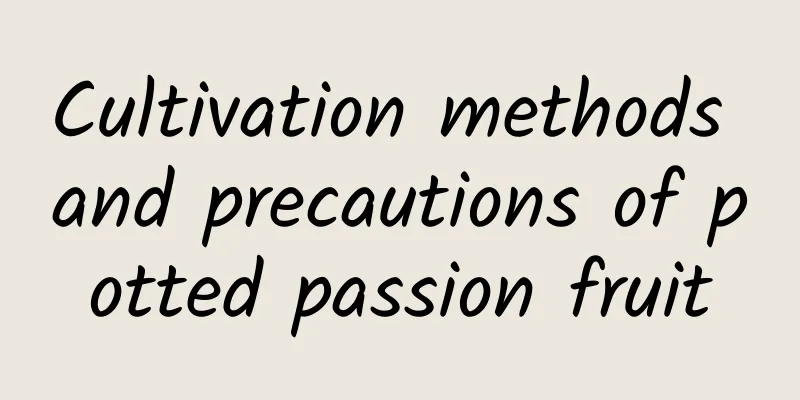Cultivation methods and precautions of potted passion fruit

|
Passion fruit is a fruit tree that is relatively easy to manage and cultivate, but if you want it to have a good harvest, you can't just leave it alone. Although it is not very demanding on the soil, humus-rich soil is better. The flowerpot should be as large as possible, with a diameter of more than 30 cm. Foam boxes are very commonly used containers. How to grow passion fruit in potsPassion fruit needs more sunlight during daily care. The more light the better. It likes high temperatures. In winter, the potted plants should be moved indoors to overwinter. During the period of vigorous growth of passion fruit, it should be irrigated with compound fertilizer water every half a month. Before flowering, use phosphorus and potassium fertilizers. When the main vine of passion fruit grows to 1m in height, cut off the top buds, and pinch off the side branches again when they grow to 1-2cm. 1. Choose potting soil: For potted passion fruit, you should choose a flower pot of moderate size. For seed planting, you can choose a smaller clay pot or a tile pot, and use loose, fertile, breathable and well-drained soil. Passion fruit does not require much soil, garden soil, humus soil, and an appropriate amount of perlite are enough. 2. Lighting: Passion fruit likes plenty of sunlight to promote branch growth and nutrient accumulation. If there is insufficient light, it will grow slowly, have many leggy branches, grow slowly, and even cause the fruit to shrink and fall off. The recommended sunshine time is more than 12 hours, which can promote flower bud formation and flowering. Generally, if the cultivation and management work such as water and fertilizer is done well after planting in early spring, it will continue to bloom and bear fruit in the summer of that year. 3. Temperature: Passion fruit’s temperature requirements are basically the same as those of ordinary tomatoes. It has a wide adaptability and can be grown in both the north and south. If it is grown in the north, it is recommended to overwinter in a greenhouse. In the south, it is recommended to face the arrival of the frost season at an altitude of more than 1,400 meters. 4. Moisture management: Passion fruit is relatively drought-resistant, but if it is too dry, it still needs irrigation, because the soil is too dry, which will affect the development of vines and fruits. In severe cases, the branches will wither, the fruits will not develop and will fall. However, during the rainy season, attention should be paid to drainage. Matters Needing Attention in Caring for Potted Passion FruitWhen caring for potted passion fruit, you should pay attention to diseases and pests, which mainly include seedling damping-off disease, mosaic disease, blight, stem base rot, fruit fly, mites, scale insects, etc. For disease prevention and control, Bordeaux mixture or Ridomil, Antibacterial, Benomyl and other sprays are generally used. For pest control, Agriland liquid, Chlorpyrifos liquid, DDT, Avermectin liquid and other sprays are generally used. |
<<: Honeysuckle planting methods and precautions
>>: The pros and cons of nostalgic and elegant roses
Recommend
What flowers are suitable for growing in Taizhou? What are the city flowers and trees?
1. Climate characteristics of Taizhou Taizhou has...
Bodhi tree cultivation methods and precautions
The Bodhi tree is known for its elegant shape and...
Why Strelitzia Reginae Doesn't Bloom
If the Strelitzia reginae in your home is slow to ...
How to care for Lady Charlotte rose
Lady Charlotte Growing Conditions Lady Charlotte ...
What is the difference between longan and longan?
1. The difference between the two Longan is also ...
Can jasmine be planted in the yard?
Can I grow jasmine in my yard? Jasmine can be pla...
What should I do if scale insects infest the Buddha's seat lotus?
Symptoms of scale insects on Buddha's lotus I...
How to water camellia
Key points for watering camellia Camellia, also k...
Doubanlan maintenance methods and management
Preliminary preparations for the cultivation of d...
What to do if the leaves of peony turn yellow
1. Water appropriately: Reason: If you water too ...
What is the reason why the leaves of the money tree have spots and turn yellow?
Many families like to place money trees indoors. ...
What kind of water is suitable for watering orchids?
1. What kind of water is suitable? When watering ...
What fertilizer is good for growing vegetables on the balcony
What fertilizer to use for growing vegetables on ...
What to do if the leaves of the golden diamond curl outwards
1. Proper shade 1. Reason: Diamondwood likes sunl...
These 5 kinds of flowers can be kept alive by pinching off branches, and one pot can be turned into many pots, which is very cost-saving
Gardenia Gardenia is one of Huahua’s favorite flo...









